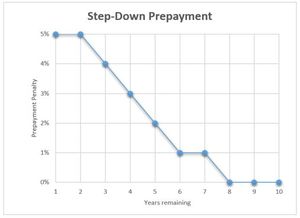Yield maintenance
| Yield maintenance |
|---|
| See also |
Yield maintenance also known as make hole charge[1], is a penalty for prepayment, in which case the borrower repays the loan before maturity, the lender can achieve the same profitability, as if the borrower has made all scheduled mortgage payments to maturity[2].
Definition
The formula is the difference between the loan rate and the rate at which the price would have been measured was on the market, taking into account the remaining period. Another way of looking at this is that it is the current value of the remaining loan payments multiplied by the difference between the interest rate on the loan and the tax rate at the same time[3].
Model
The yield maintenance usually is related to some percentage of the interest to be paid or to value of e.g. treasury notes. Therefore, there is no one formula for calculating yield maintenance penalty. An example formula can be:
where:
- YM - yield maintenance
- PV - present value of remaining payments
- IR - interest rate
- TY - treasury yield
The present value is calculated using discount ratio based on treasury yield.
Types of prepayment penalties
also known as "payment" in the industry, is a contract between the borrower and the bank or mortgage lender, which regulates what the borrower can pay back and when. In addition to yield maintenance, here are two other types[4][5]:
- Step-Down, is a kind of prepayment penalty gradually decreasing during the loan period. A typical ten-year term may have a prepayment penalty following: 5-5-4-3-2-1-1-0-0-0. In this simple example, we see that in the first two years of the loan amount to the borrower's penalty five percent of the existing loan balances. If the borrower wants to avoid the cost of early repayment, he must wait until the year 7 of its duration.
- Defeasance is an alternative to the formula of maintaining profitability, which can bring benefits to the borrower. Although there are some administrative costs, including a possible additional fee for prepayment, in total the potential profit significantly exceeds these costs.
Comparison of yield maintenance and defeasance
Speaking of prepayment methods, they are basically identical in terms of loan repayment, however with different methods[6]. Both called a quick exit startegy. Though the two servethe exact same purpose, they are fundamentally different.
In the case of yield maintenance, the borrower must repay[7]:
- loan's unpaid principal balance,
- prepayment penalty.
Whereas defeasance is determined by[8]:
- price of the bond portfolio, which are sufficient to cover the remaining loan payments
- transaction fees(third parties).
Footnotes
References
- Burke D. B.,(2006)Estate Transactions: Examples and Explanations Aspen Publishers Online, 2006
- Fabozzi J. F.,(2001)Investing in Asset-Backed Securities John Wiley & Sons, Nov 9, 2001
- Fabozzi J. F., Dunlevy J. N.,(2001)Real Estate-Backed Securities John Wiley & Sons, Jul 2, 2001
- Fisch E. P., Berg L. M., (2015)The Role of Defeasance In Real Estate Finance "New York Law Journal" Volume 254, 4, 8 July 8, 2015
- Marshall D., CCIM, (2018)Mastering the Art of Commercial Real Estate Investing: How to Successfully Build Wealth and Grow Passive Income from Your Rental PropertiesMorgan James Publishing, Sep 4, 2018
- Moulin S., (2017)Modeling the financial management of a commercial bank Lulu.com, Feb 9, 2017
Author: Agnieszka Katarzyna Sikora
.
